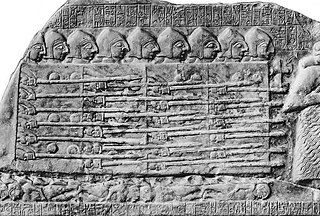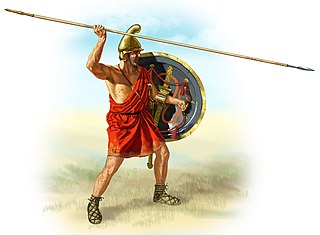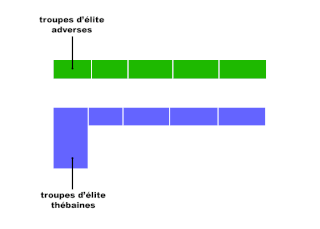Related Research Articles

Aelianus Tacticus, also known as Aelian, was a Greek military writer who lived in Rome.

The Battle of Issus occurred in southern Anatolia, on 5 November 333 BC between the Hellenic League led by Alexander the Great and the Achaemenid Empire, led by Darius III. It was the second great battle of Alexander's conquest of Asia, and the first encounter between Darius III and Alexander the Great. The battle resulted in the Macedonian troops defeating the Persian forces.

The Battle of Gaugamela, also called the Battle of Arbela, took place in 331 BC between the forces of the Army of Macedon under Alexander the Great and the Persian Army under King Darius III. It was the second and final battle between the two kings, and is considered to be the final blow to the Achaemenid Empire, resulting in its complete conquest by Alexander.

The Battle of the Granicus in May 334 BC was the first of three major battles fought between Alexander the Great of Macedon and the Persian Achaemenid Empire. The battle took place on the road from Abydus to Dascylium, at the crossing of the Granicus in the Troad region, which is now called the Biga River in Turkey. In the battle Alexander defeated the field army of the Persian satraps of Asia Minor, which defended the river crossing. After this battle, the Persians were forced on the defensive in the cities that remained under their control in the region.

A flying wedge is a configuration created from a body moving forward in a triangular formation. This V-shaped arrangement began as a successful military strategy in ancient times when infantry units would move forward in wedge formations to smash through an enemy's lines. This principle was later used by Medieval European armies, as well as modern armed forces, which have adapted the V-shaped wedge for armored assault.

The phalanx was a rectangular mass military formation, usually composed entirely of heavy infantry armed with spears, pikes, sarissas, or similar pole weapons. The term is particularly used to describe the use of this formation in ancient Greek warfare, although the ancient Greek writers used it to also describe any massed infantry formation, regardless of its equipment. Arrian uses the term in his Array against the Alans when he refers to his legions. In Greek texts, the phalanx may be deployed for battle, on the march, or even camped, thus describing the mass of infantry or cavalry that would deploy in line during battle. They marched forward as one entity.
Asclepiodotus Tacticus, also known as Asclepiodotus, was a Greek writer and philosopher known for his treatise on military tactics.

The army of the Kingdom of Macedon was among the greatest military forces of the ancient world. It was created and made formidable by King Philip II of Macedon; previously the army of Macedon had been of little account in the politics of the Greek world, and Macedonia had been regarded as a second-rate power.
The Strategikon or Strategicon is a manual of war regarded as written in late antiquity and generally attributed to the Byzantine Emperor Maurice.
Lochagos is used in the Greek language to mean "Captain". More precisely, it means "leader of a lochos". The equivalent term in the Hellenic Army Armour & Cavalry is Greek: ιλάρχος, romanized: ilarchos, "leader of an ilē.

The oblique order is a military tactic whereby an attacking army focuses its forces to attack a single enemy flank. The force commander concentrates the majority of their strength on one flank and uses the remainder to fix the enemy line. This allows a commander with weaker or equal forces to achieve a local superiority in numbers. The commander can then try to defeat the enemy in detail. It has been used by numerous successful generals. Oblique order required disciplined troops able to execute complex maneuvers in varied circumstances.
The Hellenistic armies is the term applied to the armies of the successor kingdoms of the Hellenistic period. The Hellenistic armies emerged after the death of Alexander the Great, when his vast empire was split between his successors, also known as the Diadochi. During the Wars of the Diadochi, the Macedonian army under Philip II and Alexander gradually adopted new units and tactics, further developing Macedonian warfare and improving on the tactics used in the Classical era. The armies of the Diadochi bear few differences from those of Alexander, but during the era of the Epigonoi, the differences were obvious, favoring numbers over quality and weight over maneuverability. The limited availability of Greek conscripts in the east led to an increasing dependence on mercenary forces, whereas in the west, Hellenistic armies were continuously involved in wars, which soon exhausted local manpower, paving the way for Roman supremacy. The major Hellenistic states were the Seleucid Empire, Ptolemaic Egypt and Macedonia during the Antigonid kingdom. Smaller states included Attalid Pergamum, Pontus, Epirus, the Achaean League, the Aetolian League, Syracuse, and other nations such as Athens, Sparta, etc.

This article lists and briefly discusses the most important of many treatises on military science produced in the Byzantine Empire.
A turma, was a cavalry unit in the Roman army of the Republic and Empire. In the Byzantine Empire, it became applied to the larger, regiment-sized military-administrative divisions of a thema. The word is often translated as "squadron" but so is the term ala, a unit that was made up of several turmae.
A lochos, plural lochoi, is a tactical sub unit of Classical Greece and of the modern Greek army. The term derived from the ancient Greek for ambush and the men carrying out the ambush, but in practice, its meaning was essentially that of "war-band", a body of armed men. This translation has been used traditionally, e.g. for the Sacred Band of Thebes.

The Tactica is a military treatise written by or on behalf of Eastern Roman Emperor Leo VI the Wise in c. 895–908 and later edited by his son, Constantine VII. Drawing on earlier authors such as Aelian, Onasander and the Strategikon of emperor Maurice, it is one of the major works on Byzantine military tactics, written on the eve of Byzantium's "age of reconquest". The original Greek title is τῶν ἐν πολέμοις τακτικῶν σύντομος παράδοσις. The Tactica elaborates on a wide variety of issues, such as infantry and cavalry formations, drills, siege and naval warfare etc. It is written in a legislative form of language and comprises 20 Constitutions and an Epilogue and is concluded by 12 additional chapters, the latter mainly focusing on ancient tactics.

The Balkan campaign ofAlexander the Great took place in 335 BC, against a number of rebellious vassals of the Macedonian kingdom. Alexander successfully pacified each in turn, leaving him free to begin the long-planned invasion of Persia.
The menaulion or menavlion, also menaulon or menavlon (μέναυλον) was a heavy spear with a length of 2.7 to 3.6 metres with a thick shaft, used by the Byzantine infantry as early as the 10th century AD, against enemy heavy cavalry. To give it increased strength, whole oak or cornel saplings were preferably used. These were then tipped with a long blade of ca. 45–50 cm.

The hippika gymnasia were ritual tournaments performed by the cavalry of the Roman Empire to both practice their skills and display their expertise. They took place on a parade ground situated outside a fort and involved the cavalry practicing manoeuvring and the handling of weapons such as javelins and spears. The riders and their mounts wore highly elaborate armour and helmets specially made for display purposes, decorated with images from classical mythology. Such tournaments served several purposes, improving the riders' skills, helping to build unit morale and impressing dignitaries and conquered peoples.

The Macedonian phalanx was an infantry formation developed by Philip II from the classical Greek phalanx, of which the main innovation was the use of the sarissa, a 6-metre pike. It was famously commanded by Philip's son Alexander the Great during his conquest of the Achaemenid Empire between 334 and 323 BC. The Macedonian phalanx model then spread throughout the Hellenistic world, where it became the standard battle formation for pitched battles. During the Macedonian Wars against the Roman Republic, the phalanx appeared obsolete against the more manoeuvrable Roman legions.
References
- ↑ Aelian, Taktika ch.19
- ↑ Arrian, Techne Taktike
- ↑ Aelian, Taktika ch.43
- ↑ Asclepiodotus, Tactica 7.5
- ↑ Asclepiodotus, Tactica, 7.2
- ↑ Asclepiodotus, Tactica, 7.6-10